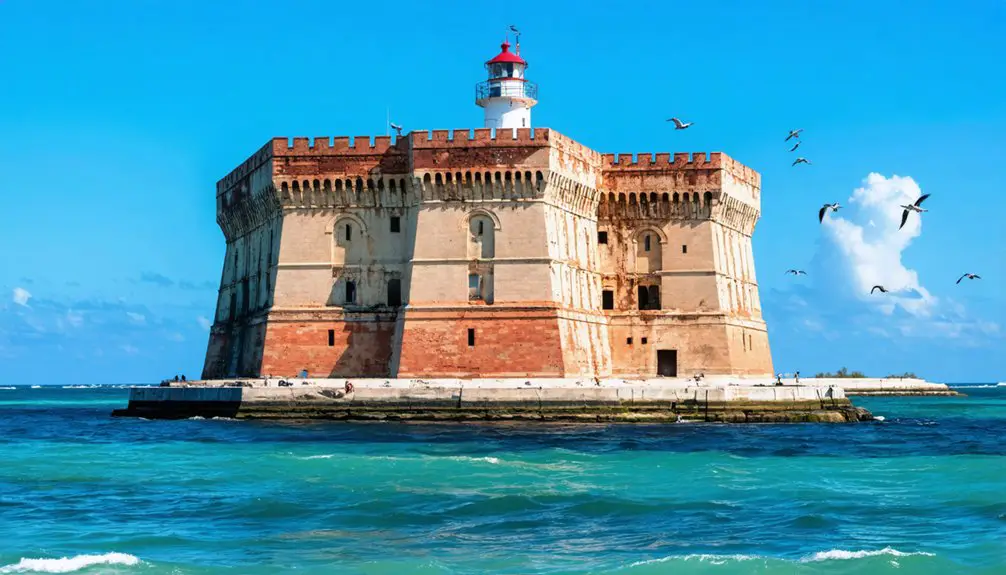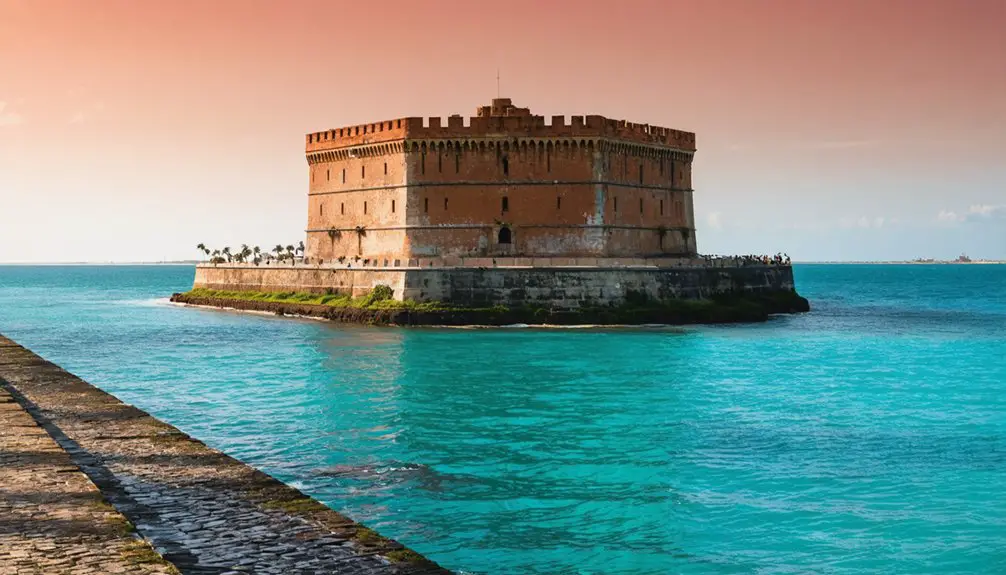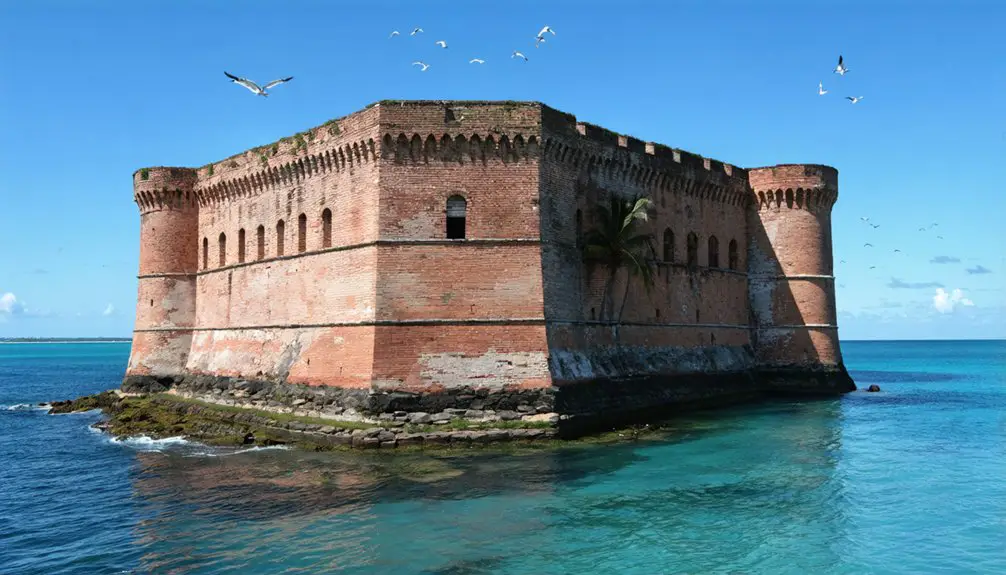You’ll find America’s largest brick fortress standing abandoned in the Dry Tortugas, where Fort Jefferson‘s massive hexagonal walls rise 45 feet above the Gulf of Mexico. Built in 1846 to control shipping lanes, this 16-acre military marvel once housed 2,000 people, including Civil War prisoners and Dr. Samuel Mudd, who was imprisoned for treating John Wilkes Booth. Today, this National Park holds centuries of secrets, from ghostly encounters to hidden shipwrecks beneath its crystal waters.
Key Takeaways
- Fort Jefferson was abandoned by the Army in 1874 due to hurricane damage and high maintenance costs, becoming a ghost town.
- The massive fortress once housed nearly 2,000 people, including soldiers, prisoners, civilian workers, and their families.
- After its military abandonment, the fort deteriorated until being designated as a National Monument in 1935.
- The remote location, 70 miles from Key West, contributed to its isolation and eventual abandonment as a military installation.
- Today, the deserted fort stands as America’s largest brick masonry structure, attracting tourists to its haunting history and architecture.
The Rise of America’s Largest Brick Fortress
When the United States acquired Florida in 1821, military planners soon recognized the strategic potential of Garden Key in the Dry Tortugas. Though initially dismissed, the site’s importance for controlling essential shipping lanes and combating piracy led to renewed interest by 1829.
The ambitious fort construction began in 1846, creating a massive six-sided fortress designed to house 1,500 men and 450 heavy cannons. Enslaved labor and Irish immigrants did most of the construction work on the massive structure. Located 70 miles from Key West, the remote fort required all supplies to be shipped from great distances.
You’ll marvel at the sheer scale – two sides stretch 325 feet while four extend 477 feet, with eight-foot-thick walls forming an almost impregnable gun platform. The military strategy behind Fort Jefferson focused on protecting southern coastlines and securing Mississippi River commerce.
Named after Thomas Jefferson, this engineering marvel required over 16 million handmade bricks, though harsh conditions, yellow fever, and the Civil War complicated its three-decade construction.
Life Behind the Fortress Walls
Life within Fort Jefferson‘s imposing walls bustled with nearly 2,000 souls during its peak, creating a complex social tapestry of soldiers, officers, civilian workers, and their families.
You’d find daily routines revolving around military drills, construction work, and essential services. While soldiers stood guard and trained, civilian workers maintained the massive structure, and women tended to domestic duties like laundry and cooking. During the Civil War, the fort served as a military prison compound. The fort’s construction required an incredible 16 million bricks to complete its hexagonal design.
Yet isolation challenges were ever-present. You’d battle intense heat, relentless mosquitoes, and the constant struggle for fresh water. Disease outbreaks, including yellow fever and scurvy, posed serious threats.
Life on the island meant endless battles with heat, insects, and thirst, while deadly diseases lurked in the shadows.
Despite these hardships, residents found solace in simple pleasures – swimming in crystal waters, watching dolphins play, and gathering for picnics under the vast sky, all while lighthouse keepers kept their vigilant watch over passing ships.
Notable Prisoners and Their Stories
You’ll find Fort Jefferson’s most infamous inmates were the Lincoln assassination conspirators, including Dr. Samuel Mudd who gained favor after treating yellow fever victims during a deadly outbreak.
Union Army deserters formed the bulk of the prison population, with soldiers like Private Thomas Moran leaving behind haunting poetry written by candlelight in his cell. The prisoners endured 12-hour workdays while shackled in difficult conditions. The massive masonry fortress stood as the largest structure of its kind in the Western Hemisphere.
The harsh conditions took their toll on everyone within the fortress walls, including a guard who ultimately took his own life with his service weapon.
Famous Lincoln Conspiracy Inmates
Among the most notorious prisoners ever held at Fort Jefferson were four men convicted of conspiring in President Abraham Lincoln’s assassination. Dr. Samuel Mudd, Samuel Arnold, Michael O’Laughlen, and Edman Spangler endured harsh conditions at this remote island fortress, located 68 miles from Key West.
They faced isolation, disease, insects, and poor food while serving life sentences at hard labor. During their confinement, they occupied themselves with woodworking and writing letters home. After one escape attempt, the conspirators were moved to the Dungeon for added security.
O’Laughlen died during an 1867 yellow fever outbreak, but the others eventually received pardons from President Andrew Johnson. Dr. Mudd, who’d treated John Wilkes Booth’s broken leg, gained favor after helping treat yellow fever victims at the fort.
His medical service during the epidemic likely influenced Johnson’s decision to pardon him in 1869. The fort, which had served these prisoners, was later established as a National Monument by FDR in 1935.
Yellow Fever Prison Deaths
The deadly impact of yellow fever at Fort Jefferson extended far beyond the Lincoln conspirators, claiming numerous lives during multiple epidemics in the 1860s and 1870s.
You’ll find that prisoner mortality rates varied dramatically between outbreaks – from 14% in early 1873 to a devastating 37% in a subsequent wave that same year.
Among the notable victims was Michael O’Laughlen, one of the Lincoln conspirators, but many other unnamed military and civilian prisoners also perished in the fort’s cramped conditions.
Compounding the health crisis was the prisoners’ poor diet of bread with bugs and unsanitary living spaces.
The epidemic response improved markedly under Dr. Samuel Mudd’s leadership, who rejected ineffective quarantine measures and instead focused on basic hygiene.
He insisted on clean bedding and proper patient care, helping to reduce death rates compared to other regional outbreaks of the era.
The fort’s location made it particularly vulnerable, as Key West’s strategic position as the Gibraltar of the Gulf had attracted significant military presence despite known disease risks.
Civil War Deserter Tales
While Fort Jefferson’s most famous prisoner was Dr. Samuel Mudd, the fort’s cells primarily held Civil War deserters who faced a grim reality.
You’d find over 1,000 men who chose to flee military service, only to end up in what they called “a sentence worse than execution.”
Take John Cannivan’s tale – he deserted twice before military justice caught up with him. Rather than face execution, President Lincoln’s 1861 policy sent deserters to this tropical prison.
You can imagine the harsh conditions these men endured – brutal heat, scarce resources, and punishing labor under the watch of 600 guards.
While eight prisoners managed to escape, most deserters served their time in isolation, stripped of military pay and honor, their fate sealed in this remote fortress they’d grimly nicknamed “Devil’s Island.”
Engineering Marvel in the Gulf of Mexico

You’ll find Fort Jefferson’s most impressive feature in its sheer scale – a 16-million-brick hexagonal masterpiece that stands as the largest masonry structure in the Americas.
While the fort’s engineers designed it to rest on coral foundations, they encountered significant challenges when the structure was actually built on shifting sands, leading to settling and cracking issues throughout the massive walls.
The fort’s construction techniques nonetheless showcase remarkable period engineering, incorporating materials from across America including Northern bricks, Louisiana wood, and Pennsylvania nails, all assembled into a sophisticated defensive complex spanning 16 acres.
Structural Design Challenges
Built on a remote Garden Key in the Gulf of Mexico, Fort Jefferson faced extraordinary engineering challenges that pushed 19th-century construction capabilities to their limits.
The massive structure required over 16 million bricks to complete, with foundation stability constantly threatened by shifting sands and coastal storms. You’ll find evidence of ingenious adaptations throughout the fort, including an incomplete second tier – a calculated decision to reduce weight on the unstable soil below.
The harsh marine environment proved relentless in its assault on the fort’s integrity.
Saltwater and humid air accelerated corrosion management problems, particularly where iron shutters were embedded in brick walls. The expanding rust pushed apart masonry, while chloride exposure degraded mortar joints, creating an ongoing battle between nature’s forces and human engineering.
Masonry Construction Techniques
Standing as the largest brick masonry structure in the Western Hemisphere, Fort Jefferson showcases extraordinary construction techniques that defined 19th-century military engineering.
You’ll find over 16 million bricks meticulously assembled into eight-foot-thick walls, arranged in a three-tiered system for maximum defensive strength.
The fort’s builders employed innovative brick soaking techniques, submerging each brick for up to 28 days to prevent future expansion issues.
Their loadbearing techniques were equally impressive, using vaulted construction to distribute the weight of 420 heavy cannons across six fortress sides.
They mastered the challenge of tying new vaulting into existing walls through precise engineering, using wooden forms and false pintles to guarantee perfect arch construction.
These methods created a structure that’s withstood the test of time despite its remote location.
Tales of the Supernatural
Numerous supernatural tales surround Fort Jefferson, with Dr. Samuel Mudd’s restless spirit being the most frequently reported apparition.
You’ll hear stories of ghostly encounters throughout the fort’s dark corridors, where visitors and rangers alike describe spectral whispers, unexplained orbs of light, and shadowy figures.
The fort’s tragic past fuels these haunting legends. Over 30 people died from yellow fever outbreaks, while others met their fate through executions, violence, and natural disasters.
The isolation and suffering experienced within these walls have made it one of Florida’s most haunted locations. Built upon ancient coral reef skeletons and battered by hurricanes, the ever-shifting island landscape only adds to the supernatural atmosphere, where many believe the spirits of prisoners and personnel still linger in the fort’s weathered chambers.
From Military Stronghold to National Park

As construction began in December 1846, Fort Jefferson emerged as an ambitious military project on Garden Key in the Dry Tortugas.
You’ll find America’s largest brick masonry structure here, with over 16 million bricks covering 16 acres and featuring six bastions and a 70-foot-wide moat.
The fort’s military evolution began after the Civil War when its strategic importance waned.
By 1874, the Army abandoned the fortress due to hurricane damage and high maintenance costs.
Despite costly upkeep and storm destruction, Fort Jefferson ultimately proved too burdensome for the Army to maintain.
You’ll discover that preservation efforts started when it became a quarantine station in 1888, managing maritime health threats.
President Roosevelt declared it a National Monument in 1935, and in 1992, it was re-designated as Dry Tortugas National Park.
Today, you can explore this remarkable piece of history by boat or seaplane.
Hidden Secrets of the Dry Tortugas
Deep beneath the turquoise waters surrounding Fort Jefferson, you’ll find a treasure trove of historical secrets spanning over three centuries. More than 300 shipwrecks lie scattered across these treacherous reefs, including the legendary Nuestra Senora de Atocha, discovered by treasure hunting pioneer Mel Fisher in 1983 after a devastating 1622 hurricane claimed it along with 500 lives.
You’re exploring waters once ruled by pirates and privateers who used these shallow channels as hideouts while preying on merchant vessels.
Even more intriguing, recent discoveries have revealed a submerged Civil War-era cemetery and hospital site near the fort.
While treasure hunting draws many visitors, it’s the rich marine life, including nesting sea turtles and vibrant coral reefs, that now claims these waters as a protected sanctuary.
Frequently Asked Questions
How Deep Is the Moat Surrounding Fort Jefferson?
You’ll find the moat depth varies between a few feet to possibly 10 feet, influenced by Gulf tides. Its historical significance wasn’t about depth but serving as a defensive water barrier.
What Was the Average Life Expectancy of Prisoners at Fort Jefferson?
Like candles burning at both ends, you’d have faced grim odds at Fort Jefferson, where harsh prisoner conditions and sky-high mortality rates from disease and neglect likely limited life expectancy to under 5 years.
Did Any Women Ever Serve as Guards or Staff Members?
You won’t find any records of women serving as official guards or staff members at the fort. Women’s roles were limited to domestic duties as wives of officers or informal support.
What Indigenous Peoples Inhabited the Dry Tortugas Before Fort Construction?
Like shifting sands beneath tropical tides, you won’t find evidence of permanent settlements here. Though Calusa culture and Taino influence touched these shores, they’d only visit temporarily for fishing and turtling.
How Many Shipwrecks Lie in the Waters Surrounding Fort Jefferson?
You’ll find over 200 shipwrecks in these treacherous waters, making it a globally significant maritime archaeology site. The area’s shipwreck history spans Spanish treasure fleets, pirate vessels, and modern military wrecks.
References
- https://moonmausoleum.com/ghostly-whispers-in-the-dry-tortugas-fort-jefferson/
- https://www.youtube.com/watch?v=S5_M2ug53y0
- https://en.wikipedia.org/wiki/Fort_Jefferson_(Florida)
- https://www.drytortugas.com/fort-jefferson-history/
- https://fla-keys.com/keysvoices/fort-jefferson-echoes-of-the-past/
- https://www.howderfamily.com/blog/fort-jefferson/
- https://sah-archipedia.org/buildings/FL-01-087-0034
- https://ana-usa.com/projects/fort-jefferson-key-west-florida/
- https://www.travelyesplease.com/travel-blog-dry-tortugas-fort-jefferson/
- https://www.drytortugas.com/fort-jefferson-life/



